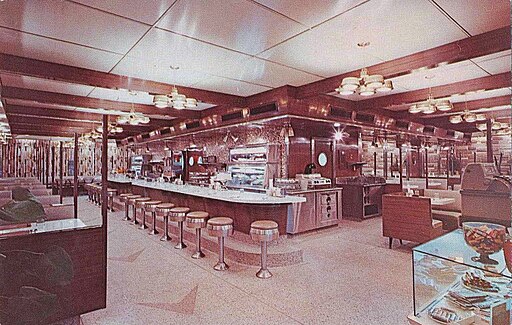
Steel Trolley Diner – One of the Final 50s Diners Built

The Steel Trolley Diner was opened in 1955 by Salem, Ohio businessman Jim Aldom. He purchased the diner in 1954 from the Elizabeth, New Jersey based Jerry O’Mahoney Company. The Steel Trolley was one of the final diners built by the company before their closure in 1952. It arrived in Salem, Ohio by way of two flat railroad cars. Though the diner has changed hands numerous times, and is currently not where it originally stood, it has remained in Columbiana County for 65 years. but has changed hands in ownership numerous times. After operating the diner for 20 years, Aldom sold it to Charles Forsythe in 1975. Only four years later, it was purchased by Wayne Darling. The diner was then almost immediately sold to Lisbon native Shirley Davis. In May of 1979, Shirley moved the diner to its present location on the historic Lincoln Highway; America’s first coast to coast highway. Shirley Davis would continue to operate the diner until 1992, when she then sold it to two other Lisbon residents – Earle and Jacki Hersman. As of 2020, Jacki has owned the diner with her son, Ryan Hillman for the past 28 years.


The Steel Trolley Diner was, for 42 years, one of Lisbon, Ohio’s most notable places to visit. After it closed in January of 2018 the community has been hoping to see it reopen. It has, in a very big way, been a Columbiana County landmark for 65 years.

The diner is one of the 600 or so still standing today. This is quite a feat, when you consider that there were previously over 6,000 of these diners across the United States. Of the 6,000 or so that once existed, The Jerry O’Mahony Diner Company produced about 2,000 of them from 1917 to 1952. Of those 2,000, the Steel Trolley Diner is one of few remaining today.



More and more of these historic diners are being forgotten, scrapped and demolished. The Lisbon community, among many others hope to see this one survive. It’s unfortunate that so many others have been tossed aside. These diners are a staple of our history, and should be preserved, not destroyed.
So how did these diners come to rise in popularity in the United States in the first place? We can take this all the way back to the late 19th century with street carts offering snacks and lunches to hungry people on the go. These carts had eventually made the transition to larger lunch wagons. Think modern day food trucks, only with splintered wood and a questionably dirty-looking appearance. Walter Scott is the first known American pioneer of these wagons. Though, while many of these wagons may have been more worn down, cheaply made and questionable in cleanliness, some displayed elaborately designed coffee urns and etched windows, alongside intricate woodwork and other Gilded-Age decor.



Along comes lunch wagon manufacturer Patrick Tierney, whose design would come to earn him the title of creator of the polished diner image. His prefabricated eatery designs featured tiled floors and indoor restrooms, which at the time was unheard of for such a place. During this time, train dining cars had become the standard for food service on the move. Manufacturers began running with Tierney’s designs, combining them in the image of dining cars seen on trains. These manufacturers then began building and shipping these train-like dining cars across the US. People would eventually begin shortening the name, simply calling them “diners” by the mid-1920s. These diners would eventually become America’s most widespread 24-hour public establishments, and would become an essential part of urban culture, along with bars and nightclubs.

Most trains in the 1930s took on a chrome, streamlined look to match one of the most popular trains at the time: the 1934 Burlington Zephyr train. As trains started to take on this look, diners would follow to match. Roland Stickey, a New York inventor and designer had put together the design for the Sterling Streamliner diner model for the J.B. Judkins Company of Massachusetts. It was the first model to look so much like a train that people thought it may actually be a train car missing the engine or passenger cars. The design quickly grew to popularity, and similar designs were soon being shipped across the country. Most of these were built in New Jersey, which is still often noted as America’s diner capital for this reason.
Diners were originally shipped by either truck or train, which was the main reason for their limited, long and minimal design. For years they could only be shipped in one piece. In the 1940s however, the Paramount Diner Manufacturer had come up with a way to design them so that they could be shipped in multiple pieces and constructed on site, freeing diners from their restricted shapes.

Diners and soda fountains had eventually become a symbol of prosperity and optimism in America during the 1950s. Being open for 24 hours a day, diners brought anyone from teenagers on dates to overnight factory workers. They had also served as symbols of loneliness and isolation as seen in Edward Hopper’s iconic 1942 painting entitled Nighthawks.

The well-known painting shows a few occupants sitting at the counter of a quiet diner, which glows softly, giving off the warm night light in an urban setting. Also fitting to their history of human connection between Americans, you could look to Normal Rockwell’s 1958 painting, The Runaway.

This painting features a young boy and a highway patrolman at the counter of an anonymous diner.

Today, many non-prefab restaurants continue to imitate the look of these diners, including franchises like Denny’s, often with their interior design. Waffle House is another to keep up the interior layout derived from these diners.





